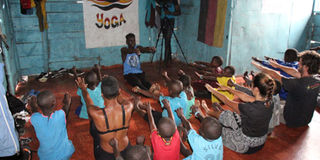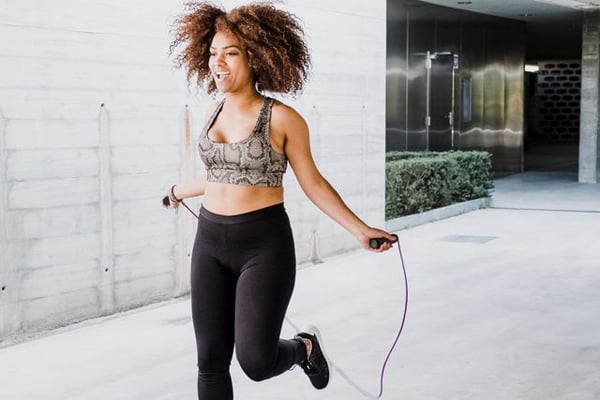Rehabilitating Kisenyi through yoga

George Okurut conducts a class with children and other community members. Photos by Andrew Kaggwa.
What you need to know:
Rehab. Yoga is a physical and mental practice that many could easily associate with high end dance studios, yet, out of goodwill, the slums of kisenyi are slowly using the physicals to rehabilitate street children, writes Andrew Kaggwa.
There was a time when George Okurut could barely move, he had been hospitalised for nine months after being involved in an accident.
Then, his back was in pain and yet, most of the time he lay on it since he limited his own movements.
It was during this uncertainty that he was introduced to yoga, a group of physical, mental, and spiritual practices or disciplines which originate in ancient India.
Through dedication, Okurut says, yoga restored his life that when Joaquin Galarza, a friend from the US proposed that they start a class for yoga in a refugee camp, he was more than willing to.
“Yoga helps someone think about themselves. During the sessions you connect with your inner self,” he says.
Unfortunately, since he lacks qualifications of a yoga trainer, the refugee camps they went to declined the classes.
However, while attending a jam session at the National Theatre, another opportunity came when he was introduced to Geoffrey Sekidde, a football enthusiast, who runs a football initiative comprising street children and those from homes in Kisenyi.
“Sekidde invited us to his place in Kisenyi, he liked the idea of teaching the children yoga there,” he says.
Taking yoga to slums
Galarza had acquired the place where the studio is after it had been vacated by a church that had failed to pay rent. But since nothing was taking place in the space. It was being used by different people including Sekidde.
The first yoga class comprised seven children that were from the neighbourhood, but with a few of these trainees, the group went around Kisenyi not only creating awareness about the center but also making different yoga poses.
This was the birth of Kisenyi Slum Yoga an initiative that rehabilitates, empowers and resettles street children while indirectly using body movement that is yoga as therapy.
Okurut was the first teacher at the project that even when he is no longer an instructor there, the relationship he still has with many of the children is visible when he comes around. The way he is quick to hug them, crack jokes before getting into a conversation about their life and what they have been up to the past week.
On this particular Sunday, most of the children do not seem to be having the best of time. One is for example, lying on the floor because he had had a scuffle with a security guard the previous night. “Shops were closing and I was looking for plastic waste when a security guard saw me,” he says.
He claims that the guard hit his knees with a baton and his left knee got severely hurt, thus he cannot train with his peers but sit and watch today’s practice.
“Many times, the children come here with injuries,” says Moses Ndawula, the head of Kisenyi Slum Yoga.
Most times they cross paths with law enforcers though on other days, the boys confirm that they run from likely molesters, rapists and traffickers.
Kisenyi is regarded as the city’s biggest slum, the Kisenyi Yoga Slum attracts about 20 children from the streets and communities around daily.
What you get is what you see
Unlike the many projects that are started in Uganda, this one is informal. For instance, instead of a neat office, walkways or banners that greet you in such offices, this one confronts you with reality.
From the time you jump over the first sewage trench, the project manifests its unconventional nature; located behind one of the biggest makeshift cinema halls in Kisenyi, the tiny pathway between two houses; one has stood the test of time while the other has unbaked bricks.
Most of the time, the narrow walkway even becomes smaller thanks to a group of youths that place stools in between to enjoy recreational pot and khat leaves.
“At midday, when they are getting intoxicated, the walkway becomes unusable, especially for a stranger. You could easily get robbed,” Ndawula says.
At times, you will find yourself in someone’s compound but they are barely bothered, since most of the structures are not planned this side of town. Things such as compounds are luxuries.

Stretch: Children go through different yoga pose drills. Photo by Andrew Kaggwa
A tiny stained wooden room with faded blue paint is in a wet area and the cold has since eaten part of the floor which is made of a brown carpet that may have made the studio seem modern.
Since they started operations almost six months back, Ndawula says they open their doors for an entire week but only conduct yoga sessions six days, which he says are the busiest.
What kind of children are there
Every morning, Ndawula says they hit the streets to collect the children; “many of them do not sleep through the night”.
“These children spend much of the night looking for scrap from different shopping arcades and they try to catch a break in the morning and our space is open as an alternative.”
Most of the time they come to sleep, eat porridge and later go for their daily hustle, yet on days they have yoga sessions, they sleep, train and have lunch.
“On yoga days, the number is bigger because many of them come here for a decent meal,” Ndawula explains.
And the programme is curated in a way that informs participants that there is a reward at the end of the training, thus, they willingly go through the drill because they know a meal, soda or bottled water awaits them at the end.
When the children are at the centre, they prohibit them from using any intoxicants.
“we do not want to control them thus, we only ask of them to desist the drugs when they are here,” Ndawula says, adding that as they frequent the sessions, they slowly cut on the drugs and hope, they will eventually give it up.
The main aim of the project is to help relocate the children from the streets, at least to that room that currently serves as their dance studio. In fact, four children that formerly lived on streets stay at the studio permanently.
“We have been able to even convince a number of them to go back to their parents but many eventually return.”
Coming to the streets
One of the boys that only refers to himself as Rogers, says he left home after an altercation with his stepmother.
“I only let her know that she did not own any of my father’s property and I do not know what she told dad, he was really furious,” he recalls.
Rogers did not wait for the punishment, he left home and ended up on the Kampala streets. He says once, he was put on a taxi heading home but alighted on the way.
While John Akansha says he ran away from home because his father always confiscated his items.
“He always took away my radios and sunglasses.”
Akansha chose to revenge by stealing his father’s phone. However, since his network was not big enough, he sold the phone to someone that turned out to be a friend of his father.
“When my father came home and asked me where his phone was, I pretended like I had no idea, but when I learnt that he had it, I imagined he knew I had sold it, I left before he confronted me,” he says.
Unlike his peers, Akansha says he has never spent the Christmas holidays on the streets since he always goes back home: “I keep coming back to the streets because, it is hard to experience this lifestyle and you settle in a home again.”
Akansha seems like one of the best students they have at the centre but a conversation with him proves something else, for instance, he neither comes with drugs nor does he use them in the open, but this is not because he is cleaning up.
“I regulate the way I sniff things. I usually start by taking at least a cup of porridge and a rolex, then I can be sure that regardless of what I smoke, the effects will be minimal,” he says.
Okurut notes that street kids are vulnerable and many people are always looking at exploiting them.
“Over time people will make a call when they are looking for about 20 street children to present to someone as beneficiaries of a certain programme and will not even pay them for putting up the act,” he says.
The yoga drills
Today, Okurut only does a few yoga drills with the boys and hands them over to Aisha Mbabazi.
Mbabazi is not a professional yogi but she, too, started the training while in need. “I had a problem of controlling urine, I would simply pass it out.”
However, she says after doing yoga for some time, the problem slowed down and today, everything has normalised.
Since this is not a body movement therapy, the session moves between basic poses of yoga such as the down dog, cobra and the thunderbolt which the children are still struggling to master.
At times, they even do moves not related to what Mbabazi is teaching since they simply want to do something similar to what she is showing them.
For the time she has been a trainer, Mbabazi says she has worked with all sorts of children. “Some believe they are supposed to be paid to do yoga while others only come to eat,” she says.
And of course, being a woman, some boys earlier on in the training had promised to beat her up,
“But as they keep coming around, they start changing their attitude. Today, some even come in the morning to clean,” she says.
Ndawula says they are looking at changing more than the appearance of the children that frequent the studio.
At the moment, he says, they want the change these children are going through to be organic and not forced so as to encourage more to warm up to a clean life and while at it, flexing their muscles.




